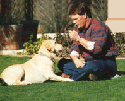 |
|||
|
|
 |
 |
|
|
 |
||
|
What Tone Do You Take With Your Dog? The other day I was in one of those huge pet-food mega-store. A woman was having difficulty keeping her dog under control. She pulled and tugged on the dog’s leash and kept up a running, one-sided conversation with her dog. As the dog continued to buck and pitch, her voice got more harsh. The dog didn’t seem to notice. After about 20 seconds, an employee showed up and quietly asked the dog to sit, while waving a small treat in front of the dog’s face. Not surprisingly, the dog suddenly paid attention to the soft spoken and treat-laden employee. So much for “tone of voice.” For the last few thousand years, people have modified their speech when asking their dogs to do things. While some owners prefer a harsh, loud yell, others favor a hissed-through-clinched-teeth-paramilitary command-tone. Regardless of the style, the logic behind these methods is obvious – commands should be verbally intimidating. Other trainers recommend that you overly enunciate the words, while others prefer that you bark the commands, in imitation of your dog’s ancestors. As all of these recommendations area capable of failure, it’s also obvious that real obedience isn’t all about being verbally threatening. A couple of real-life example points out the fallacy of tonal obedience. The same dog that won’t stay, even when you scream at him, can hear a potato chip fall on thick carpet from 20 feet away. Before the chip has a chance to bounce, the dog has unerringly raced to the spot and devoured it. The chip has no power to intimidate, yet has an ability that many macho owners don’t – the ability to get the dog to “come”, consistently. The most powerful proof of this phenomenon is as close as your own front door. All dogs who live in houses react to the doorbell. No one sets out to teach this association. Despite the fact that behavior is self taught, the dogs surpasses all standards of obedience when the doorbell begs for attention. Consider this…
One of the reasons that these erroneous rules have been overwhelmingly accepted is that they can easily become self fulfilling prophecies. If you get into the habit of saying all your commands in a loud voice, Fluffy will soon ignore soft commands. You have inadvertently told her that the sound of the command is not as important as how loud it is.If you fall into the loudness trap, you may soon be using multiple commands, as well. When Fluffy ignores your soft command the first time, you will automatically repeat yourself, louder. Now you are convinced that it was the loudness of the command that caused the behavior to fail. If you get into this habit of trying your commands in a regular tone of voice and then escalating the volume, you may soon find yourself repeating commands until Fluffy obeys. In nature, animals must listen to subtle sounds in order to survive. The secret behind getting your animal to pay attention to you has little to do with the loudness of your voice, the shortness of the commands or how many times you repeat yourself. The real secret to obedience is to make your pet’s responses connected to predictable consequences. If you find yourself repeating your commands, speaking harshly, yet getting little response, here is a simple program for getting back on track.
Training Articles Index | Home
|
||
|
Copyright 1994-2013 Gary Wilkes. All rights reserved.
|
||

